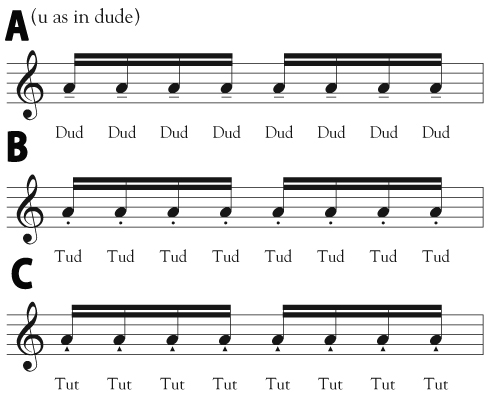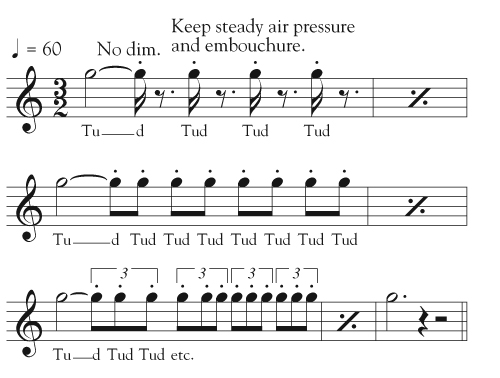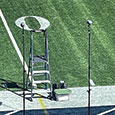I have always been fascinated with the playing techniques of other instruments and how they might relate to the flute and piccolo. During my 53-year orchestral career (6 years with the Rochester Philharmonic and 47 years with the Chicago Symphony), I was the perennial next-door neighbor to either the second violins or cellos, and thus developed an abiding respect for the string family sonority. My December 2000 Flute Talk article, “Learning from the Violins” (the original title was “A Bow to the Strings”, but my polite pun was editorially vetoed), was a salute to the strings in their role as the foundation for the orchestral sound. In that article I wrote about bowing techniques, highlighting many of their similarities to our breathing and articulation approaches.
My seating position as the “tight end,” so to speak, of the woodwind section also allowed me to bask in the beautiful sounds of the oboes, bassoons and clarinets. I was especially grateful for having had the opportunity to study those instruments as a graduate student at Eastman in 1948-50, when I was privileged to take private lessons with the principal players of the Rochester Philharmonic on oboe, bassoon and clarinet. I studied each instrument for one semester, oboe with Robert Sprenkle, bassoon with Vincent Pezzi, and clarinet with William Osseck.
Of those three instruments it was the clarinet that held the most interest for me, partly because of its extended fingering system with its alternating use of the little finger of either hand to manage an extended scale and overblowing at a twelfth rather than an octave (as with the other woodwinds). More than anything else, however, it was clarinet tonguing technique that gave me a fresh perspective for refining my flute articulation.
Included in the pedagogical materials that I acquired during my clarinet semester was a mini-sized book by Daniel Bonade, Clarinetist’s Compendium. I was a big fan of Bonade, having heard many of his recordings as principal clarinet of the Philadelphia and Cleveland orchestras. I particularly admired his articulation style, so when I came upon Chapter 3, “Method of Staccato,” it was like an epiphany. The still prevalent myth, “never stop the note with your tongue,” was thoroughly demolished by Bonade’s logical explanation on page 8:
The principle of staccato is not to hit the reed with the tongue but to have the tip of the tongue on the reed and move it backward and forward intermittently at different speeds as needed. Consider staccato as an interruption of legato. This will be discovered in the first exercises.
I repeat, in making staccato, the tongue moves back and forth, with the pressure of the wind always the same, as though playing legato. The faster the interruption, the faster the staccato.
Of course Bonade took it for granted that the return of the tongue to the reed should be quick but not forceful. A distractingly noisy slap-tongue release should be avoided, unless specifically requested by a composer as a special effect.
In my April 1995 Flute Talk article, “A New Perspective on Note Releases (Introducing the T-U-D Factor)”, I cited Bonade’s Clarinetist’s Compendium, and designed a few exercises patterned after his “Method of Staccato” with special emphasis on their critical relevance to the piccolo. Unfortun-ately, Bonade’s book was out-of-print at that time, but it is now available again for purchase online at music dealers such as Hickey’s Music Online, Van Cott Information Services, and others. I highly recommend its purchase, not only for his “Method of Staccato” chapter, but also for his excellent advice about tone, breathing, articulation and phrasing. (You may, however, happily skip the final chapter, “The Art of Adjusting Reeds”.)
Here are the relevant sections reprinted from my 1995 article, including the brief Bonade-style exercises at the end:
* * *
Flute Talk Classic
A New Perspective On Note Releases
April 1995
When tonguing sixteenth-note passages at speeds from q = 88 and faster, one of the main goals of a wind player is to maintain clarity and precision with the recurring, tongue strokes. If all the elements of articulation – tongue tension and evenness, breath pressure, embouchure position, and finger-tongue synchronization – are working optimally, a player need not be overly conscious of note “releases” since these occur automatically due to the tonguing momentum. That is, fast tempos make it necessary for the tongue to return to its starting position quickly in order to attack the next note on time. Thus the cessation of one note and the initiation of the ensuing note are virtually simultaneous.
Assuming that the breath pressure remains constant, a legato style of tonguing could be transcribed syllabi-cally as in Example A. A more staccato style could be depicted as in Example B, and an extreme, hard staccato style would be more like that shown in Example C. The tempos of these three examples would be q = 88 to about q = 126.

When performing detached notes at slower speeds, flutists and piccoloists have six additional techniques available to them for making note releases (some of these are applicable to other wind instruments):
1. Stopping the air flow internally by quickly suspending the abdominal pressure. This suspension of abdominal pressure immediately reduces the velocity of the air remaining in the respiratory “pipeline,” causing the end of the tone to go flat or fall into the lower octave or fifth (in the case of all notes above Eb5). This technique is not recommended unless carefully coordinated with methods 3 or 5.
2. Stopping the air flow internally by closing the glottis (the opening between the vocal cords). This is almost identical to the glottal sensations one experiences when laughing or doing staccato whistling sounds. The “pipeline” here is much shorter than in No. 1, so there is little likelihood of suffering the pitch and octave control problems of No. 1. If used too emphatically, however, as for example when applying glottal releases in conjunction with abdominal pulses and soft tongue strokes (sometimes erroneously referred to as “diaphragm staccato”), this can cause excessive throat tension. From a musical point of view, also, this method tends to give the tone a diffused quality, lacking in definition.
3. Stopping the air flow internally (as in No. 1), but at the same time adjusting the embouchure as if making a very quick diminuendo. If one is skilled at making artistically rapid diminuendos without loss of pitch or quality, this can be a musically effective method. It works best with detached semi-staccato eighth-notes at tempos under q = 66.
4. Stopping the air flow externally by sealing the lips. This is often an unintended result of overdoing the previous method and is unreliable for regular use, particularly in the first octave and a half.
5. Dissipating the air flow externally by a sudden and dramatic opening of the mouth by a quick lifting of the maxilla while the jaw (mandible) remains in place. Combined with technique No. 1, this seems to be the instinctive method of choice for many flutists and piccoloists because the sudden enlargement of the embouchure opening causes the air flow to dissipate before the pitch has a chance to go flat. The deftness of the upper lip lift (once it has been mastered) is of course preferable to the relative clumsiness and inefficiency of the upper jaw lift. Even though this quick air dissipation effectively prevents flatness, if it is not done with precise timing and skill there still remains the risk involving the notes above G2 falling to the lower octave or fifth. The piccolo is especially vulnerable to this risk, and has a frus-tratingly low tolerance level for this technique. In fact, this unforgiveness constitutes one of the most important differences between the two instruments. It is also interesting to note that of all the woodwind and brass instruments, the flute and piccolo are the only ones that do not require the upper lip to be in contact with the mouthpiece or reed while performing. Although this apparent freedom can be advantageous, it can also be easily negated by carelessness (see my article in the October, 1993 Flute Talk, page 27: “Flutists’ Common Mistakes” – The Opening Hiccup Breath).
6. Dissipating the air flow externally by quickly taking the instrument off the lower lip. As absurd as this may seem at first glance, this technique can have an occasional place in one’s ploys-of-showmanship bag. Akin to the string player’s custom of dramatically whipping the bow off the string at the end of a very intense note, this method is actually an emphatic extension of method No. 5 and could be used in terminating a sustained forte final note of a movement or piece, such as the Bb6 that ends the Hindemith Sonata. At the very least, it can be applied during practice as a psychological tool to counteract the widespread tendency for making sagging diminuendos on what should be strong note endings. I sometimes whimsically refer to this technique as the “whiplash release.”
Having pointed out in method No. 5 the special dangers inherent in slower speed detached notes on the piccolo, what can be done to ameliorate this octave-grace-note-spillover syndrome? The solution is really very simple, and resides innocently (and invitingly) in the midst of the syllabification pattern of the rapid sixteenth note sequence illustrated earlier in Example B.
If the tud articulation of Example B works so perfectly and naturally in fast passages, why not take advantage of this tee-you-dee approach (as I refer to it in my teaching) in slower staccato passages? The reason seems to be that too many of us have fallen prey to the prevalent myth that “one should never stop a note with the tongue.”
The fact that we have six different ways (admittedly, not all of them viable) of stopping a note without using the tongue has perhaps deluded us into believing that we should never use the tongue to end a note. Yet, we blithely overlook the successful use of tongued releases exemplified by Example B.
Aside from its impressive functions as a taste sensor and masticating aid the tongue is one of the most remarkable organs of our body in its enormous repertoire of movements in speech communication. Go back for a moment to the phrase above with the bold-face letters. These letters represent the sounds directly controlled by the tongue. Pronounce the words of that phrase aloud very slowly, and you will appreciate anew the wonderful sensitivity and agility of the tongue. It has direct responsibility for articulating the following consonants th, t, n, g, s, r, k, I, d, ch, z. The tongue’s ability to move in many directions quickly or slowly, strongly or delicately, with almost infinite gradations, makes it a truly virtuoso performer, and thus deserving of wider recognition as a reliable choice in our toolbox of release techniques for slower detached notes.
One of the unrecognized advantages in using the tud stroke in detached staccato phrases is that during the split second while the tongue rebounds to its starting position, the size of the air flow escape-channel quickly shrinks, causing the air speed to increase somewhat. This is a crucial factor in pre-venting flatness or the octave-grace-note-spillover at the moment of release, especially in soft passages.
In learning to apply the tee-you-dee technique to detached notes, try the following two exercises, and continue into all notes within the range of the piccolo and flute.1 In the first exercise avoid the normal diminuendo taper at the end of the opening long note. While keeping the air pressure steady, stop the note with a gentle but quick return of the tongue to its starting position. Another challenge is keeping the air pressure steady behind the tongue during the ensuing dotted-eighth rest, at the same time maintaining your normal embouchure position as if you were still playing. Then tongue the next three short notes as indicated with the tud syllables, again keeping the air pressure steady behind the tongue during the rests. Take a breath only when necessary which should not be very often.2 Your reward for being so disciplined and patient is that at the end of the exercise you may taper the final note without using the tongue to assist the release.
Exercise No. 2 begins with normally fast single-tongued sixteenth notes, then gradually slows down by virtue of the rhythmic changes. Maintain the tud sequence throughout, and avoid the temptation of opening your mouth during the rests in measure three. Practice both exercises at different dynamic levels, but since the softer dynamics are somewhat more difficult to control, they should be practiced more.

Practice this exercise on all pitches and varied dynamics.
.jpg)
Keep steady air pressure and embouchure throughout.
Notes:
1 These are similar to the exercises prescribed by the celebrated clarinetist Daniel Bonade in his self-published pamphlet, Method of Staccato (1949), a work that 1 have admired and referred to often over the years. It has long been out of print, but for those who are interested, it might still be found circulating within the clarinet fraternity.
2 Lest there be any misunderstanding, 1 hasten to add that keeping the air pressure and embouchure intact during such relatively long rests should not be considered a normal procedure. I only advocate it here as a disciplinary strategy for improving awareness and control, and as a preliminary set-up for the upcoming faster rhythms.






